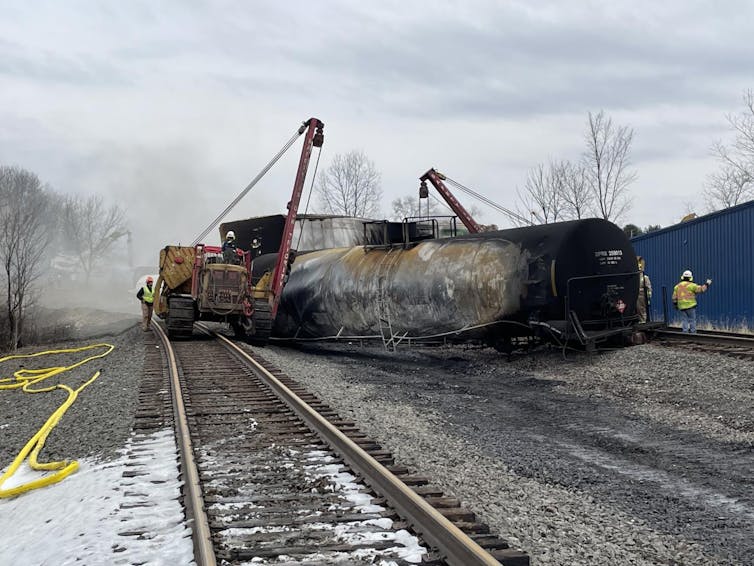
Much less than two months immediately after practice cars and trucks filled with hazardous chemical compounds derailed in Ohio and caught fire, a truck carrying nitric acid crashed on a key freeway outdoors Tucson, Arizona, killing the driver and releasing harmful substances into the air.
The Arizona hazmat disaster shut down Interstate 10, a main cross-state freeway, and pressured evacuations in bordering neighborhoods.
Browse A lot more: What we know about the chemical substances aboard the prepare that derailed in Ohio
But the highway crash didn’t attract national interest the way the practice derailment did, or result in a flood of calls for much more trucking regulation like the U.S. is seeing for educate regulation. Truck crashes have a tendency to be community and considerably less extraordinary than a pile of derailed train cars on hearth, even if they are deadlier.
In actuality, federal info exhibits that rail has experienced considerably fewer incidents, deaths and injury when transferring hazardous elements in the U.S. than vans.
Vehicles have much more hazmat and far more threat
At one particular time, rail and drinking water have been the only choices for transporting chemical substances and other possibly unsafe resources. The emergence of the car and subsequent building of the interstate freeway system transformed that, and harmful elements shipments by highway steadily elevated.
Right now, vehicles carry the premier share of harmful resources delivered in the U.S. – about twice as considerably as trains when calculated in ton-miles, in accordance to the Department of Transportation’s Bureau of Transportation Statistics’ most recent info, for 2017. A ton-mile is a single ton shipped for a person mile.
Whilst truck incidents involving dangerous materials really don’t seem as spectacular as teach derailments and are not as broadly coated by news media, federal knowledge demonstrates they signify much more fatalities and property harm, and there are hundreds far more of them every year.
Truck-linked dangerous products incidents caused above 16 instances far more fatalities from 1975 to 2021 – 380 for truck, when compared with 23 for rail, in accordance to the Bureau of Transportation Data. The variation is more pronounced in the final decade, when U.S. rail transportation of hazardous materials triggered zero fatalities and truck incidents have been accountable for 83.
Vehicles have also brought about nearly three instances as much house damage as rail incidents given that 2000. That may possibly seem to be shocking given that derailments can involve a number of autos with dangerous components. But most rail situations get area in remote parts, restricting their human impression, when trucks travel on highways with other drivers close to and typically in chaotic city regions.
Where by do we go from here?
I study rail devices and regulation, and I have followed the rising charges to the industry to comply with tightening regulatory regulations.
Transport harmful products in the U.S. has been regulated for about 150 many years. A lethal explosion in San Francisco in 1866 involving a just-arrived cargo of nitroglycerin, utilised for blasting rock, led to the 1st federal laws regulating shipping explosives and flammable components.
The Sept. 11, 2001, terrorist assaults spurred a extensive growth of regulation more than movement of harmful materials. A lot of towns now have harmful supplies routes for trucks that circumvent city facilities to minimize the opportunity danger to high-inhabitants spots.
With the Ohio educate derailment now earning nationwide news, lawmakers are focusing on rules specifically for rail.
Ohio’s governor desires rail organizations to be expected to notify states of all dangerous shipments. This knee-jerk response to a key celebration would surface to be a dependable demand with comparatively minimal fees, but it would have no effect whatsoever on avoidance of hazmat situations.
Check out: Release of toxic chemicals from educate derailment in Ohio prompts broader basic safety considerations
Activists are calling for a lot more highly-priced investments, including prerequisites for warmth sensors on train bearings, which appeared to have been included in the Ohio derailment, and the restoration of a rule requiring state-of-the-art braking devices for trains carrying harmful components. Equally would elevate the expense of rail delivery and could wind up putting extra harmful materials shipments on U.S. roadways. The Trump administration repealed the braking process prerequisite in 2017, arguing that the expenses outweighed the positive aspects.
U.S. Transportation Secretary Pete Buttigieg, talking with reporters, talked about on the lookout into new rules for advanced braking systems, increased fines and encouraging rail companies to velocity up their section-in of more puncture-resistant tank vehicles.
Rail is nevertheless a lot more inexpensive and improved for the setting than vehicles for for a longer period distances, but with at any time-expanding polices, rail transport can be economically and logistically discouraged – chasing a lot more website traffic to considerably additional hazardous roadways.
If the concern is the public’s publicity to hazardous resources, regulation on street-based mostly dangerous components transportation ought to grow as perfectly.
This report is republished from The Conversation beneath a Inventive Commons license. Read through the first article.
![]()








